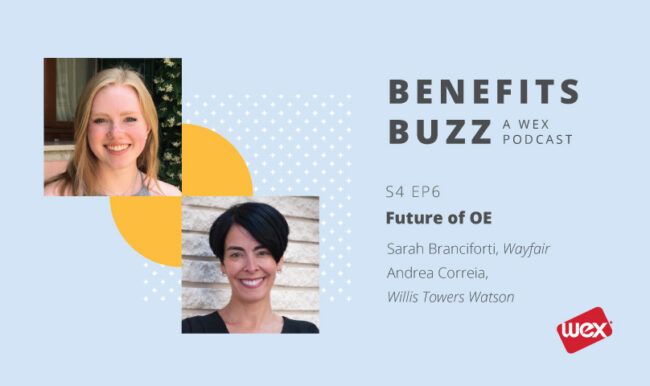Stay connected
Subscribe to our health benefits blog and follow us on social media to receive all our health benefits industry insights.

Open enrollment last year was unlike any other open enrollment for many employers. And it might never be the same again. To promote social distancing and support employees working from home during the pandemic, 67 percent of employers told us that they did open enrollment differently in 2020. And 85 percent who hosted a virtual open enrollment fair plan to do so again, even when the COVID-19 pandemic is behind us. Why? In many cases, because it worked better.
In our latest episode of Benefits, we chatted with Sarah Branciforti, senior benefits specialist at Wayfair, and Andrea Correia, director of talent at consulting firm Willis Towers Watson, about their open enrollment success story. Wayfair used a virtual open enrollment last year to better reach employees during the pandemic.
Watch now to learn tips on what you can do heading into your next open enrollment, or keep reading to learn how they felt Wayfair’s employees benefited from a virtual setup.
Your employees’ benefits may not just cover that employee. Spouses and children could also be covered by their benefits. And oftentimes the employee’s spouse is the benefits decision maker in the family. By providing a virtual open enrollment, your employees can include their spouses so both can better understand what’s available.
“They’re the ones who also take advantage of the benefits that Wayfair offers,” Correia said.
With a virtual open enrollment fair, employees can participate whenever they have time. With an in-person open enrollment fair, that’s not the case. In-person availability is usually limited to a few time slots.
Correia has noticed increased employee participation with virtual fairs. Correia said they’ve found that employers get three times more employees to participate virtually than in-person due to the convenience of it.
“We do our best job to try to get all employees involved and get the information out there for them,” Branciforti said. “We were trying to find a way to build off that. In came the virtual benefits fair.”
With in-person open enrollment fairs, timing is often the biggest determining factor for attendees. Because of that, broad messaging is needed to reach them. On the other hand, virtual fairs can be set up tailored to specific employees so they only get the information they need, based on their eligibility.
“We can segment the actual rooms that people could see based on what they were eligible for,” Correia said. “For example, if you aren’t eligible for the retirement plan, you wouldn’t see the room for that. It does seem like it’s more of an experience for you and what benefits you’re eligible for.”
Data drives decisions. And with a virtual open enrollment fair, it’s much easier to collect participation data and collect feedback directly from employees. Plus, once you have that information, you can make changes to the fair right away to improve the experience.
“You can survey people after every room and at the end,” Correia said. “You can get continuous feedback from people visiting so you know what’s working and what’s not working. You can adjust ongoing since it’s digital. You can make changes pretty easily.”
Do you want to learn more about last year’s open enrollment experience? Get your free white paper and infographic to find out what we learned from our post-enrollment survey that will help you in 2021.
The information in this blog post is for educational purposes only. It is not legal or tax advice. For legal or tax advice, you should consult your own counsel.
Subscribe to our health benefits blog and follow us on social media to receive all our health benefits industry insights.